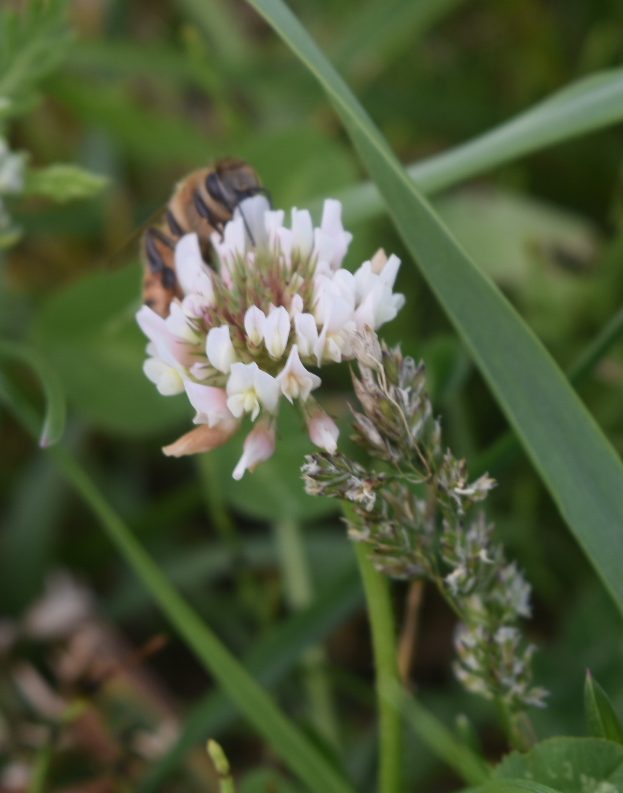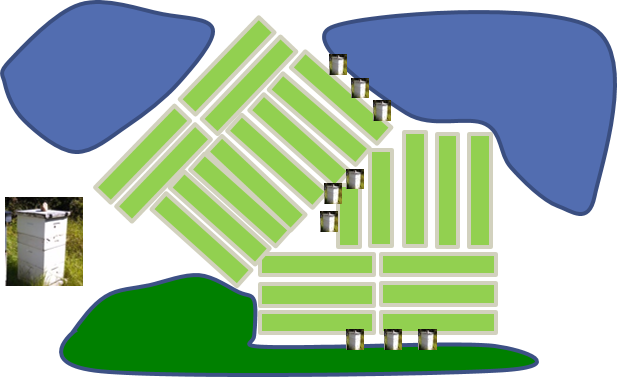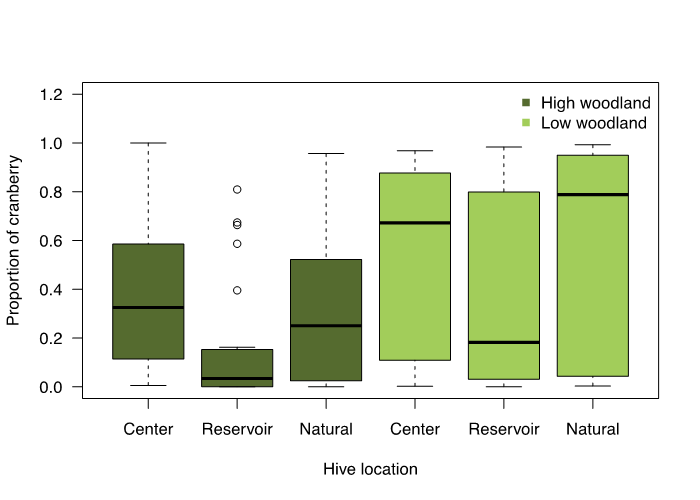Abby Lois, Aidee Guzman, and Christelle Guédot
Effect of Hive Placement on Honeybee Foraging in Cranberry
Pollination services are important both economically  and ecologically. In cranberry, most growers use honey bees for pollinating cranberry flowers, averaging $140 to $210 per acre, and thousands of dollars being spent each year on honeybee rentals to ensure cranberry pollination. Past studies in cranberry marshes have reported anywhere from 97% to only 10% of honeybees visiting flowers offsite. In Wisconsin, cranberry marshes are embedded within a mosaic of agriculture and native vegetation and the surrounding landscape may impact honeybee fidelity to cranberry by providing alternative floral resources, while providing native pollinators with the habitat and resources needed throughout the summer.
and ecologically. In cranberry, most growers use honey bees for pollinating cranberry flowers, averaging $140 to $210 per acre, and thousands of dollars being spent each year on honeybee rentals to ensure cranberry pollination. Past studies in cranberry marshes have reported anywhere from 97% to only 10% of honeybees visiting flowers offsite. In Wisconsin, cranberry marshes are embedded within a mosaic of agriculture and native vegetation and the surrounding landscape may impact honeybee fidelity to cranberry by providing alternative floral resources, while providing native pollinators with the habitat and resources needed throughout the summer.
Growers have reported that rented honeybees tend to fly off the marsh into the woods to forage on other resources, suggesting that the proximity to additional resources may influence honeybee foraging behavior. Also, barriers such as water reservoirs on cranberry marshes may redirect honeybees to forage on cranberry. This study aimed to determine the fidelity of honeybees to cranberry by assessing the effect hive placement and landscape attributes in the vicinity of the marsh have on pollinator foraging.
METHODS OVERVIEW
Eleven marshes in Central Wisconsin were selected for analysis during the 2015 production season. Each marsh was classified as “high” or “low” woodland according to the land cover data within 1 km of the marsh. Marshes were considered high  woodland if more than 60% of the surrounding area contained woodland, and low woodland marshes exhibited primarily open habitat (surrounded by less than 30% woodland land cover). Three hive locations were determined within each of the eleven marshes: one in the center of the marsh surrounded by only cranberry beds and dikes, the second on the edge of the marsh near the surrounding natural habitat, and the third near a marsh’s water reservoir. A pollen trap was mounted on the entrance of each hive and pollen samples were collected for 24hr periods throughout early and peak bloom. Each sample was analyzed for pollen composition.
woodland if more than 60% of the surrounding area contained woodland, and low woodland marshes exhibited primarily open habitat (surrounded by less than 30% woodland land cover). Three hive locations were determined within each of the eleven marshes: one in the center of the marsh surrounded by only cranberry beds and dikes, the second on the edge of the marsh near the surrounding natural habitat, and the third near a marsh’s water reservoir. A pollen trap was mounted on the entrance of each hive and pollen samples were collected for 24hr periods throughout early and peak bloom. Each sample was analyzed for pollen composition.
RESULTS
Surrounding landscape, high or low woodland, had a significant impact on pollen composition. Low
woodland hives exhibited the highest proportions of cranberry pollen, near 50%, suggesting that some foraging is still occurring offsite or on dike plant species. Hives in high woodland environments collected lower amounts of cranberry pollen regardless of hive locations (see figure).

Hives placed in the center of the marsh collected the highest proportions of cranberry pollen in both high and low woodland areas. Hives near woodland habitat on the edge of the marsh collected slightly lower amounts of cranberry pollen as hives in the center of the marsh. Hives bordering water reservoirs exhibited the lowest percentages of cranberry pollen, especially in high woodland environments.
RECOMMENDATION
Based on our results, we encourage growers and beekeepers to place honeybee hives near the center of the marsh when possible and away from edges of water reservoirs for optimal pollinator efficiency. Placing hives on edges with natural habitat may be a valid option for those looking to spread hives more evenly throughout the marsh.
A huge thank you goes out to our collaborators who participated in our study
(cranberry growers and beekeepers alike). And thank you to WCB, CI, and Ocean Spray for
funding this research.
